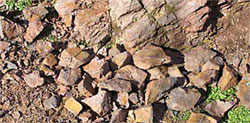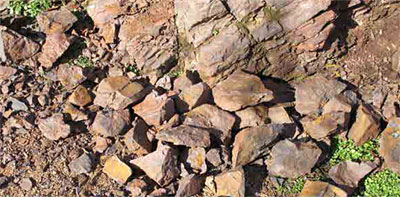Zakázanka
Menu- Welcome to Zakázanka
- In search of bygone eons
- An example of a reverse fault and a crush zone
- Folds
- A fault separating two geological periods
- Iron ore
- Exposed boundary
- What is growing here (1)
- What is growing here (2)
- Little warm lovers
- Sun lovers
- Bedrock
- Fluvial sandy gravels of the vineyard terrace
- Local denizens of the air
- A window into Prague's geological past
- Iron ore on the zoo grounds
- The rock face bears silent witness
- Regeneration of the rocky steppe
Iron ore on the zoo grounds
Iron ores were the essential raw material for the growth of Czech metallurgy in the 19th century. They formed part of the Paleozoic (Ordovician) marine deposits from around 450–480 million years ago located between Prague and Pilsen, in the area called Barrandien.
Iron ore has a distinct reddish-brown color, indicating the presence of iron.
Here we can see an exposed seam of high-quality iron ore. In the past, extraction was actually repeatedly contemplated and surveys were conducted. However, the thickness of this layer is so scanty that extraction would not pay off (the deposit contains only several thousand tons). If you take a piece of hematite in your hand, you will be surprised at how heavy it is.
Ores
These iron ores were formed when iron-rich weathered rocks found on a nearby landmass were eroded by flowing water, which then sometimes became mixed with freshly settled volcanic dust. This created the possibility of iron being brought by the streams of hot liquids that gushed out during volcanic activity. This is what happened in the case of the iron ore found in this exposure: It is a volcanic tuff strongly saturated with hematite (whose chemical formula is Fe2O3). The nearest place where iron ore of the same age and composition was once mined was on Červený vrch (Red Hill) in Vokovice. Iron ores are no longer mined in the Czech Republic.

